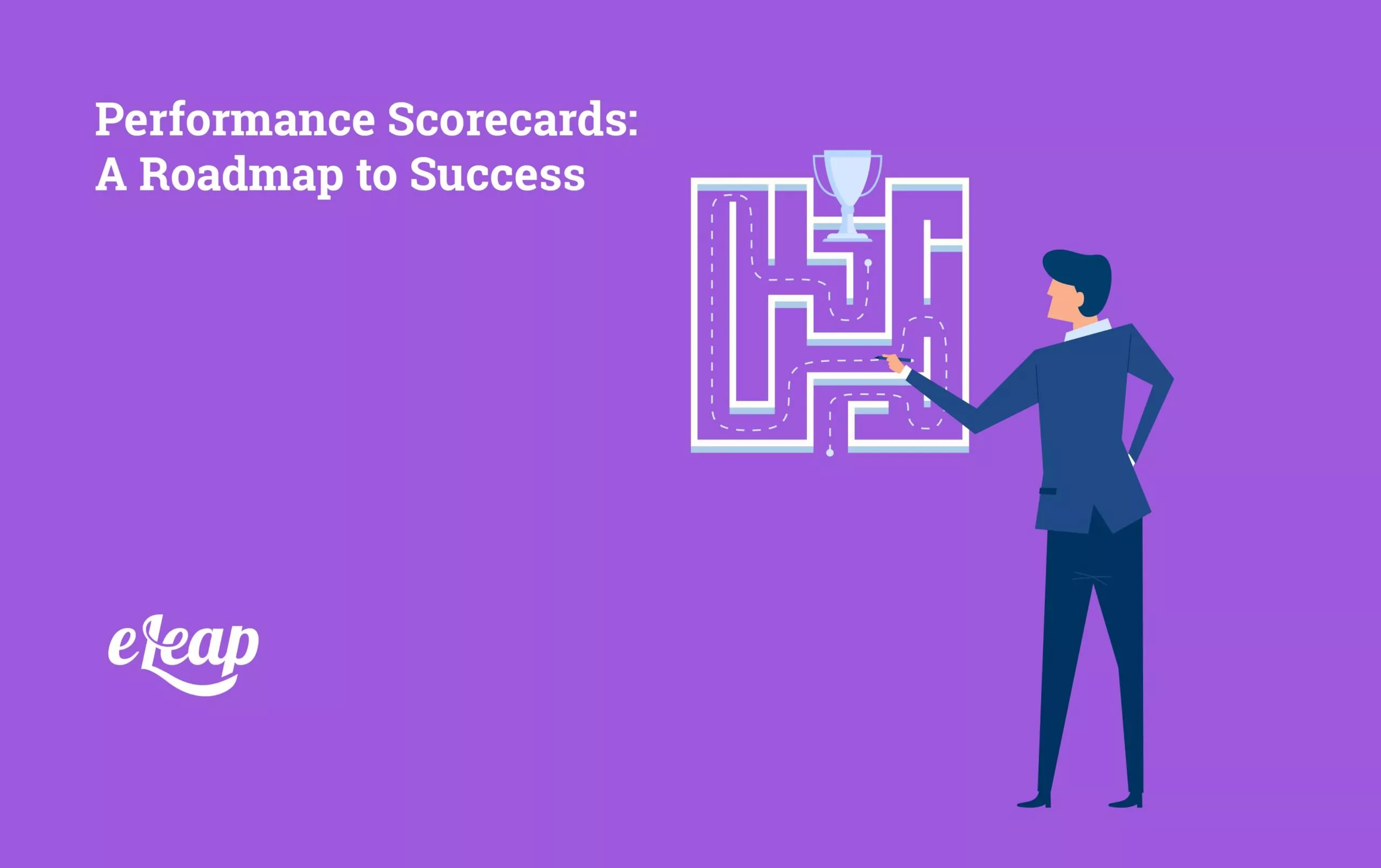Performance Scorecards: A Roadmap to Success

A performance scorecard is a strategic tool organizations use to measure and monitor their effectiveness in achieving key business objectives. Unlike traditional performance reviews, which are often reactive and one-dimensional, performance scorecards provide a holistic, proactive approach to tracking progress across various departments and functions. These tools help organizations focus on critical success factors by presenting data-driven insights that align with overall business goals. Explore how eLeaP®’s Performance Management Platform can simplify evaluations, boost productivity, and drive measurable results.
Performance scorecards visually represent performance, displaying key metrics and objectives in an easy-to-understand format. These empowering teams monitor performance, identify areas for improvement, and take corrective actions when necessary. Performance scorecards are beautiful because they align operations with long-term strategic goals, ensuring the organization is working towards a unified vision.
While performance scorecards have existed for some time, their importance has only grown as organizations seek to become data-driven and efficient. These tools are now a cornerstone for businesses in various industries, from technology startups to global enterprises. Organizations can track success and drive continuous improvement by implementing effective performance scorecards.
This article delves into the essential aspects of performance scorecards, including their types, design, implementation, and best practices. Whether you’re looking to refine an existing scorecard system or develop one from scratch, this guide will equip you with the knowledge to leverage performance scorecards for organizational success.
What Are Performance Scorecards?

A performance scorecard is a strategic management tool that consolidating critical business metrics into one unified document. These scorecards focus on financial performance, operational efficiency, customer satisfaction, and internal processes. They are designed to provide a snapshot of how an organization or specific department performs against set goals and key performance indicators (KPIs).
Unlike traditional reporting methods, which focus on individual performance metrics, scorecards are structured to assess an organization’s overall effectiveness by considering multiple aspects simultaneously. These aspects often include financial outcomes, customer satisfaction, internal operations, and employee growth. By assessing these diverse dimensions, performance scorecards provide a balanced performance management approach, ensuring no critical area is overlooked.
The key to a successful performance scorecard is its ability to align metrics with strategic goals. This alignment ensures that every action and decision an organization makes contributes to the long-term objectives. In essence, performance scorecards help bridge the gap between strategy and execution.
Types of Scorecards & Their Purposes
Several performance scorecards exist, each with a unique purpose and approach. One of the most widely known is the Balanced Scorecard, which evaluates an organization from four perspectives: financial, customer, internal processes, and learning and growth. The Balanced Scorecard is particularly useful for organizations that must align their strategic objectives with their operational activities, ensuring that performance is assessed from multiple angles.
Another type of scorecard is the Operational Scorecard, which focuses on an organization’s day-to-day activities. Operational scorecards track operational efficiency, quality, and productivity metrics and provide real-time feedback on how healthy processes are running. This type of scorecard is especially valuable for organizations that want to focus on continuous improvement at the tactical level.
Project Scorecards track the progress and success of individual projects. They are typically used in industries with complex projects and specific, measurable goals, such as construction, IT, and healthcare.
Each type of scorecard serves a different function, and organizations often use a combination of these scorecards to get a complete view of their performance across various levels.
Core Components of a Performance Scorecard
The core components of a performance scorecard include goals, KPIs, and metrics. The goals define the organization’s goals, while the KPIs and metrics track progress toward these goals.
For example, an organization might set a goal to increase customer satisfaction, and a KPI might be the customer satisfaction score derived from surveys. Similarly, financial performance can be tracked using metrics such as revenue growth or profit margins. Operational efficiency might be measured through metrics like cycle time or defect rate.
Additionally, many scorecards incorporate benchmarks, which provide a point of comparison to gauge performance against industry standards or competitors. This comparison helps identify areas where the organization excels or needs improvement.
The Power of Performance Scorecards: Why They Matter
One of the primary benefits of performance scorecards is their ability to align an organization’s strategy with measurable performance. Performance scorecards take high-level strategic objectives and break them down into concrete, measurable actions. This process ensures that every department, team, and individual works towards the same goals. The result is a more cohesive organization, with precise alignment between strategic planning and execution.
For example, a company might strategically aim to improve customer retention. To this end, it can use a performance scorecard to identify KPIs such as customer retention rates, customer service response times, and customer feedback scores. These metrics will help track progress toward the strategic goal and allow teams to adjust as needed.
Data-Driven Decision Making
Performance scorecards also enhance data-driven decision-making. By providing real-time insights into how various aspects of the organization are performing, managers can make decisions based on actual data rather than gut feelings or assumptions. This stage leads to more objective, informed decisions aligned with the organization’s strategic goals.
For instance, if a company’s performance scorecard reveals slower-than-expected sales growth, managers can examine specific metrics, such as lead generation, conversion rates, or sales team productivity, to identify bottlenecks. This data-driven approach helps make more accurate decisions and optimizes problem identification and solution implementation.
Enhancing Accountability and Transparency
Performance scorecards promote greater accountability and transparency within an organization. By tracking performance across different levels and departments, scorecards clarify who is responsible for achieving specific goals. This level of transparency ensures that all team members know their roles and objectives, increasing accountability.
Additionally, performance scorecards help identify high performers and areas requiring additional support or resources. Managers can use scorecard data to recognize achievements and address performance gaps, fostering a culture of continuous improvement.
Exploring Different Types of Performance Scorecards
The Balanced Scorecard
The Balanced Scorecard, developed by Robert Kaplan and David Norton in the early 1990s, is one of the most widely adopted frameworks for measuring organizational performance. It focuses on four key perspectives: financial, customer, internal processes, and learning and growth.
The financial perspective includes traditional measures like revenue, profit margins, and return on investment. The customer perspective focuses on customer satisfaction, retention, and loyalty metrics. The internal processes perspective evaluates the organization’s internal processes and whether they are efficient. Lastly, the learning and growth perspective measures the organization’s ability to innovate, improve, and develop its workforce.
By incorporating these four perspectives, the Balanced Scorecard provides a more comprehensive view of organizational performance than focusing on financial outcomes. This process makes it particularly useful for businesses that want to ensure economic success, meet customer needs, improve internal operations, and foster employee development.
Operational Scorecards: Focusing on Day-to-Day Metrics
Operational scorecards track day-to-day performance, focusing on the efficiency and effectiveness of specific processes. They are more tactical and typically monitor key operational areas such as production, logistics, or customer service.
Unlike the Balanced Scorecard, which takes a broad, strategic view, operational scorecards dive deep into specific metrics that impact the organization’s operations daily. For example, a manufacturing company might use an operational scorecard to track production output, defect rates, and cycle times. These metrics provide immediate feedback on operational performance, helping the organization identify issues and implement improvements quickly.
Strategic vs. Tactical Scorecards
It is essential to distinguish between strategic and tactical scorecards. Strategic scorecards, such as the Balanced Scorecard, are focused on long-term goals and overall performance. Senior executives use these scorecards to assess how well the organization is progressing toward its strategic vision.
Tactical scorecards, on the other hand, are used by managers and team leaders to track short-term performance and ensure that operational processes are running smoothly. Tactical scorecards often focus on metrics like project completion rates, operational efficiency, and customer service response times.
Designing and Implementing Performance Scorecards
Step 1 – Define Clear Objectives and KPIs
The first step in designing an effective performance scorecard is defining clear objectives and KPIs that align with the organization’s overall strategy. This process involves working closely with stakeholders to ensure that the metrics chosen are relevant and measurable. For example, a company looking to improve its customer service might set a goal of reducing response times, with a KPI measuring the average time it takes to resolve customer queries.
Step 2 – Build Your Scorecard Framework
Once the objectives and KPIs have been defined, the next step is to build the scorecard framework. This stage includes determining the structure of the scorecard, selecting the appropriate tools for data collection, and deciding how the scorecard will be presented. The framework should be simple, easy to understand, and visually appealing. Tools like eLeaP, a performance management system, can help automate the creation and tracking of performance scorecards, ensuring that data is accurate and up-to-date.
Step 3 – Integrating with Organizational Strategy
The scorecard must be integrated with the organization’s strategic goals. This step means that the metrics tracked on the scorecard should directly relate to the business’s strategic objectives. The scorecard must also be reviewed and updated regularly to align with changing business needs and goals.
Step 4 – Technology Tools for Implementation
Technology plays a key role in the successful implementation of performance scorecards. Using performance management tools like eLeaP can help streamline the creation, management, and tracking of scorecards. These tools offer real-time updates, interactive dashboards, and detailed analytics, providing managers with immediate insights into performance.
Overcoming Common Challenges in Performance Scorecard Implementation
Selecting the Right Metrics
One of the biggest challenges in creating a performance scorecard is selecting the right metrics. The sheer number of potential metrics available can be overwhelming. The key is to choose a set of KPIs that are directly related to the organization’s strategic goals and can provide actionable insights.
Dealing with Data Overload
Another common challenge is data overload. With the amount of data available today, organizations often struggle to focus on the most critical metrics. Scorecards help by streamlining the data into meaningful categories and making it easy to identify trends and outliers.
Keeping Scorecards Relevant and Updated
Finally, scorecards need to be regularly reviewed and updated to remain relevant. As business environments change, so too must the scorecards. Regular reviews ensure that the scorecards align with the organization’s goals and provide meaningful insights.
Conclusion
Performance scorecards are invaluable tools for organizations that want to improve their productivity and align their operations with strategic goals. Organizations can make data-driven decisions by tracking key metrics and continuously assessing progress, leading to greater efficiency, better customer satisfaction, and long-term success.
Using the correct performance scorecard, tailored to your organization’s needs, can transform the way your business operates. Tools like eLeaP can help streamline the process, making monitoring, analyzing, and acting on performance data easier. By adopting a productivity scorecard system, businesses can ensure they are on the path to success, with measurable progress at every step.